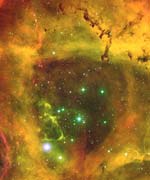
Image credit: NOAO
A Chinese and US astronomer have discovered a young star at the heart of the Rosette Nebula that is ejecting a complex jet of material with knots and bow shocks. Normally these stars are hidden from the view of optical telescopes by the surrounding nebula, but severe ultraviolet radiation from nearby massive stars has cleared out the area. This gives astronomers have a rare opportunity to study how a young star like this forms. The Rosette Nebula is located 1,500 light-years away in the constellation of Monoceros.
A duo of Chinese and American astronomers have discovered a young star in the fierce environs of the Rosette Nebula that is ejecting a complex jet of material riddled with knots and bow shocks.
Stripped of its normally opaque surroundings by the intense ultraviolet radiation produced by nearby massive stars, this young stellar object is likely one of the last of its generation in this region of space. Its tenuous state of existence exposes the limitations that young stars?and perhaps even sub-stellar objects such as brown dwarfs and large planets?face in attempting to form in such a violent environment.
A close-up image from this study of the young star, and a striking, newly reprocessed wide-field image of the colorful Rosette Nebula, are available above.
?Most young stars are embedded in very dense molecular clouds, which makes our view of the early stages of star formation normally impossible with optical telescopes,? says Travis Rector of the University of Alaska Anchorage, co-author of a paper on the young stellar object (YSO) in the December 2003 issue of Astrophysical Journal Letters. ?This is one of only a few cases where a protostar is visible, making it a valuable discovery that will be studied in detail.?
Optical images of the jet taken at the WIYN 0.9-meter telescope at the National Science Foundation?s Kitt Peak National Observatory in Arizona show a highly-collimated jet, now known as Rosette HH1, stretching for more than 8,000 astronomical units (1 AU = 150 million kilometers). It contains a prominent knot and hints of others, which can be interpreted as ?bullets? of material being ejected from the rapidly rotating YSO at hypersonic velocities on the order of 2,500 kilometers per second. Bow shocks on the other side of the YSO suggest the existence of a degenerated counterjet extending in the opposite direction.
These interpretations of the jet were bolstered by optical spectroscopy of the jet system taken by co-author Jin Zeng Li of the Chinese Academy of Sciences in Beijing using the 2.16-meter telescope of the National Astronomical Observatories of China.
?If it is indeed a counterjet, it may be the only existing observational evidence of how bipolar jets evolve into monopoles, or at least highly asymmetric jets,? according to Jin Zeng Li. ?This suggests that this infant star has been starved of material as its accretion disk is evaporated, leaving a very low-mass star. In some cases, this process might result in an isolated brown dwarf or planetary mass object, offering a potential evolutionary solution for such lone objects that have been spotted in the Orion Nebula and other nearby hotspots in the Milky Way.?
Located an estimated 1,500 light-years from Earth in the constellation Monoceros, the Rosette Nebula is a spectacular region of ionized hydrogen excavated by the strong stellar winds from hot O- and B-type stars in the center of the young open cluster NGC 2244. It is a region of on-going star formation with an age of about three million years.
Kitt Peak National Observatory is part of the National Optical Astronomy Observatory, Tucson, Ariz., which is operated by the Association of Universities for Research in Astronomy (AURA), Inc., under a cooperative agreement with the National Science Foundation.
Original Source: NOAO News Release
